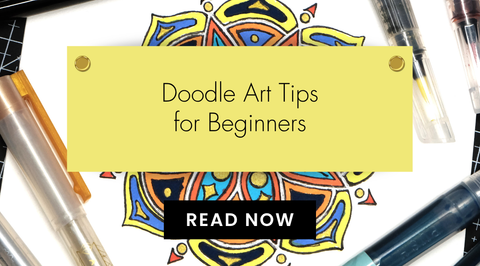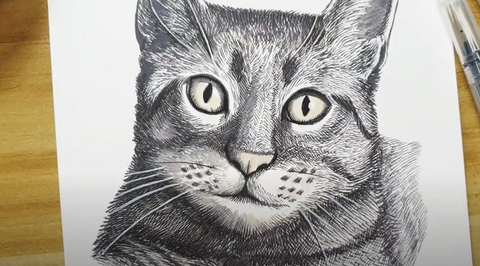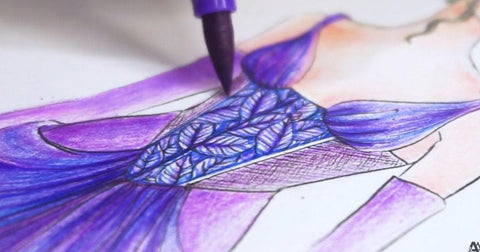10 Tips for Improving Your Drawing Skills
Last Updated: October 8, 2025
Are you an artist looking to expand your drawing skills? If so, you've come to the right place! Drawing is a great way to express yourself and create beautiful pieces of art. Whether you're looking for some tips on honing existing skills or wanting to learn something new, these ten tips will help take your artwork from OK to extraordinary. From understanding composition to drawing ideas for beginners, these how-to-draw techniques have been tried-and-true methods used by experienced and beginner artists. So, if you're ready to develop your talent further and make more masterpieces, let's get started!

1. Master the Basics of Drawing
Drawing is a skill that many people find intimidating because of its perceived complexity. But drawing doesn't have to be complicated or overwhelming! One way to begin drawing is by establishing a solid foundation for drawing basic shapes and lines. You can think of this as drawing the blueprint for bigger and more complex pieces. By starting with the basics, you can establish drawing techniques that are easy to replicate even as your drawing skills grow and develop.
Just grab some paper and pencils, take it step-by-step, and start doodling away with all kinds of drawing ideas! Never fear mistakes or imperfections – these will help you master the fundamentals of drawing in no time. Even if it's drawing a simple tree, a flower, or a portrait, the best way to master drawing is to start practicing.
2. Find a Subject That Inspires You
When it comes to easy drawing ideas for beginners, a subject that you feel really inspired by can make all the difference. Whether it’s the drawing of a loved one, your favorite landscape, or anything else that captures your attention, drawing is about letting yourself explore and revel in your creativity. Plus, you are most likely to continue practicing if you have a subject goal that you want to draw perfectly.
If you’re struggling with drawing ideas, take a moment to look around and see what inspires you. Maybe you'll see a child playing in the streets, or maybe you like the way that the sunlight hits your bedroom window. Take note of these little things and use them to fuel your motivation to draw.

3. Use Reference Images
Even when you are already experienced, it can be challenging to come up with drawing ideas on your own. Reference images can be a helpful tool when learning to draw or accurately capture a specific subject. This tip is especially helpful when you're a beginner and want to learn proper shading, proper placement of highlights and shadows, relativity, and subject composition.
Having a reference to guide you, whether it’s a photograph, a print, or even a real-life model, can do wonders for your drawing skills!
4. Experiment With Different Styles and Techniques
Refresh your creative energy by trying out different drawing and shading techniques. Cross-hatching, for example, involves drawing a series of closely spaced parallel lines that intersect to create a tonal effect. This technique is often used to create depth and texture in drawings.
On the other hand, stippling involves using dots to play around with lights and shadows to form an image. These techniques, along with others, such as scumbling and blending, can add depth and dimension to your drawings and help you to create more dynamic compositions. Don't be afraid to try out different techniques and see what works best for you – the more you practice, the better you'll become!

Monochrome Shading Pencils
5. Try Different Art Styles and See What You Like Best
If drawing is your favorite hobby and you want to draw in a new way or try out some different drawing ideas, try varying art styles! There are various art styles from which you can draw inspiration - abstract, realism, impressionism, and expressionism, for example.
Realism involves creating highly detailed and accurate representations of subjects, while abstract art involves creating non-representational compositions using shapes, lines, and color. Unlike realism, abstract art allows for more freedom and creativity as it allows you to represent subjects in your own way.
Let's say you have a reference picture of an ocean. In realism, you would try your best to depict the sea as it is in real life, with small waves and shaded areas. In abstract style, you would interpret the essence of the ocean. You can choose to draw it with angry lines instead to express intense emotions and even use geometric triangles to mimic the waves. The possibilities are endless!
Overall, not only does experimenting with different art styles improve your drawing skills, but it can also help you find your unique voice as an artist.
6. Make Drawing a Habit
Drawing can be a great way to relax and express yourself. However, like painting, sculpting, and other art forms, it is also a skill that you must hone over years of practice and dedication. To improve your drawing, start by creating a calendar of daily drawing ideas - even if it's only for a few minutes. Draw something daily based on a season, emotion, movie, song, or even a book. For example, for the entire month of October, you need to draw something spooky or Halloween-themed every day - anything goes!
By setting aside dedicated time for drawing often, you can make consistent progress and see your skills improve over time. It's important not to get discouraged if you don't see improvement right away – art is a process, and it takes time and practice to develop your skills.
7. Take up Tutorials, Classes, and Watch Videos
You can start developing your skills and confidence with the proper instruction from experts offering online tutorials or classes with practical drawing techniques. Online video tutorials are also valuable resources for those seeking assistance with drawing, as they provide step-by-step directions and in-depth visual demonstrations of the drawing process.
Whatever your level of drawing ability, it never hurts to develop your skills further and broaden your knowledge – taking up tutorials, classes, or even just watching videos on YouTube are all great ways to do just that.

Watercolor Essential 12 Pan Set
8. Seek Feedback and Learn How to Accept Criticism
If you're interested in pursuing drawing professionally, you need to get feedback on your sketches. You can do this by joining art communities and getting helpful tips on improving or even asking your art mentor to give you constructive criticism on your work.
Remember that the best way to improve is to know how our art is seen through the eyes of others.
9. Learn the Balance Between Expression and Discipline
Although art is a free world that emphasizes emotions, creativity, and imagination, there are still technical methods and guidelines that make it a concrete field of study. Drawing is still an art form with stages, lessons, and techniques you can follow. Before you can make your own masterpiece, you have to learn the proper methods. As Pablo Picasso said, "Learn the rules like a pro so that you can break them like an artist."
Be patient with yourself, and don't expect to learn how to draw a detailed landscape scenery on your first day. Go through the rigorous technical process, and you'll eventually be free to apply those skills whichever way you want.
10. Keep a Sketchbook Onhand at All Times
Inspiration can strike anytime and anywhere, so keep a portable sketchbook and pencil with you! Maybe you saw an exciting figure during your train commute or passed by an interesting building. Whatever it is, you can use your sketchbook to draw quickly on the spot. The world is a beautifully complex place, so you will indeed never run out of models and subjects to draw.
The Basis of Being a Great Artist Is to Know How to Draw!
Vincent van Gogh believed that before he could become a great painter, he needed to learn how to draw. Here at Artistry, we share the same sentiment! After all, drawing is one of the fundamentals of art, so it's only proper that you learn how to be better at it.
By following these tips and tricks, you should see your drawings start to improve over time. Remember, the more you draw, the better you'll get! If you enjoyed this post, be sure to check out our other pieces on art techniques and inspiration in our upcoming Creative Corner series!






